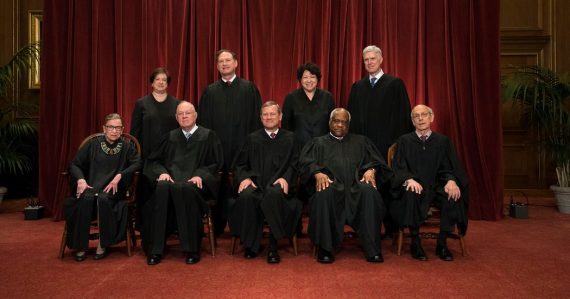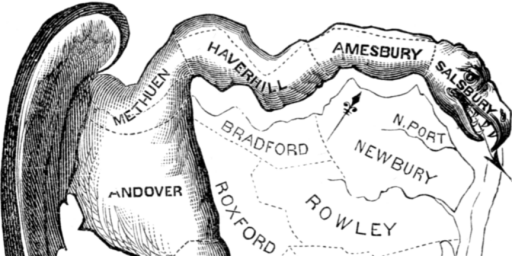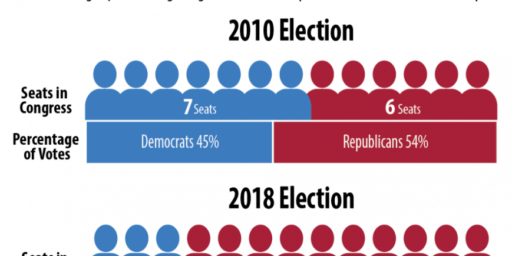Supreme Court Begins What Promises To Be A Momentous Term
Previewing the next term of the Supreme Court, which starts today.
For the first time since 2015, the Supreme Court starts a new term this morning with its full complement of nine Justices, and, unlike last year, it’s already promising to be a year filled with cases that will have major implications politically and legally:
WASHINGTON — The Supreme Court, which was shorthanded and slumbering for more than a year after the death of Justice Antonin Scalia, is returning to the bench on Monday with a far-reaching docket that renews its central role in American life.
The new term is studded with major cases likely to provoke sharp conflicts. One of them, on political gerrymandering, has the potential to reshape American politics. Another may settle the question of whether businesses can turn away patrons like gay couples in the name of religious freedom.
The court will hear important workers’ rights cases, including one on employers’ power to prevent workers from banding together to sue them. Perhaps the most consequential case involves fundamental principles of privacy in an age when cellphones record our every move.
“There’s only one prediction that’s entirely safe about the upcoming term,” Justice Ruth Bader Ginsburg said last month at Georgetown’s law school. “It will be momentous.”
The court returned to full strength in April when Justice Neil M. Gorsuch replaced Justice Scalia after a fight over the seat that lasted more than a year. In the few cases in which Justice Gorsuch participated in the last term, most of them minor, he consistently voted with the court’s most conservative members, Justices Clarence Thomas and Samuel A. Alito Jr.
Justice Gorsuch’s first full term, which will include more than the usual number of blockbusters, will bring his jurisprudence into sharper focus.
At the same time, Justice Anthony M. Kennedy, who is likely to decide closely divided cases as the member of the court at its ideological center, has been drifting left. According to data compiled by Lee Epstein, a law professor and political scientist at Washington University in St. Louis, Justice Kennedy’s voting in the term in which Justice Scalia died, ending last year, was the most liberal of any justice in that decisive central position since the mid-1960s.
Justice Kennedy is 81, and he has signaled that he is considering retirement. Should President Trump name his replacement, the court would almost certainly gain a justice ideologically similar to Justice Gorsuch, leaving it with a solidly conservative majority and thrusting Chief Justice John G. Roberts Jr. into the median position.
The court’s docket may be an embarrassment of riches, but it is also a work in progress. The justices have for now set aside arguments over Mr. Trump’s travel ban while they consider whether the administration’s issuing of a new travel order has made the current challenge moot. And there are major cases on the horizon, including one on whether a federal employment discrimination law protects gay men and lesbians.
“The upcoming term,” said Elizabeth Slattery, a lawyer with the Heritage Foundation, “promises to be one for the history books.”
One of the first major cases that the Court will hear argument on shows up on the calendar on Tuesday, when the Court will hear argument in Gill v. Whitford, a case out of Wisconsin involving the issue of how Congressional and other legislative districts are drawn and whether or not partisan Gerrymandering should be the same level of scrutiny as racial Gerrymandering has been in the past. This is an issue that has been discussed by political pundits and others with increasing frequency over the past couple of years and is often cited as one of the primary factors contributing to the increased level of partisan political polarization on Capitol Hill. Were the Justices to rule in favor of the Plaintiffs in this matter and find that partisan Gerrymandering should be subject to the higher level of scrutiny usually given to redistricting maps that result in minority votes being grouped in insular urban districts, then it could potentially go a long way toward making it harder for either political party to use the redistricting process to protect its incumbents and increase the likelihood that they will win in other areas. As I said when the Court accepted this case for review back in June, though, the Plaintiff’s arguments in this case, which are based largely on mathematical models and computer projects, seems weak, especially given the fact that there is nothing in the Constitution that explicitly or implicitly forbids partisanship from being a consideration when drawing legislative districts. This is in marked contrast to redistricting that has the intention or effect of diluting the voting power of minorities, which clearly implicates the 14th and 15th Amendments as well as several Federal laws. Combine this with the fact that partisan Gerrymandering has been a political norm since the beginning of the Republic, and it becomes hard to believe that there really is a credible argument that the practice is unconstitutional.
A second major case that the Court will hear early in the new term is Masterpiece Cakeshop v. Colorado Civil Rights Commission. This case involves a Colorado baker who declined to bake a cake for a client after discovering that was to be used at a reception for a same-sex wedding due to the baker’s religious belief that marriage should only be between a man and a woman. The couple who had ordered the cake, who were apparently previous customers of the baker, filed a complaint with the Colorado Civil Rights Commission arguing that refusing to make the cake violated the state’s public accommodation laws, which ban discrimination by businesses serving the public from discriminating on a number of grounds including sexual orientation. Making a familiar argument that has been raised in other similar cases, the baker argues that baking a cake for a same-sex wedding would violate their rights under the First Amendment both as a result of the Free Exercise Clause and the Freedom of Speech clause. This argument was rejected by the commission and by the Colorado state courts. This case does not involve the arguments we saw in the Hobby Lobby case because there is no Religious Freedom Restoration Act that applies to this situation. Instead, this is purely a First Amendment case and, as I noted when the Court accepted this case, the Court’s precedent in Employment Division v. Smith, a 1990 case in which the Supreme Court rejected the argument of a Native American who tested positive for the use of peyote that the fact that using the drug was part of a religious ceremony should exempt him from a state policy that barred unemployment insurance to someone who was terminated due to an illegal act such as drug use. Using the analysis from that case, as well as others, it would seem clear that the First Amendment claims of the baker, even if accepted as valid on their face, are not sufficient to overcome the compelling government interest involved in enforcing anti-discrimination laws. So far, this case has not been set for oral argument, but it likely will be in the very near future since the briefing process is largely complete so it’s likely that this will be argued at some point before the end of 2017.
Another case that is likely to have a major impact on the nation is Janus v. AFSCME, a case dealing with the question of whether or not public-sector unions can collect mandatory dues from people who don’t want to be or aren’t members of the union despite the fact that they receive the benefits of collective bargaining engaged in by the union. I wrote about this case just last week after the Court announced that it has accepted the case for appeal and, as I noted at the time, Court watchers at least for now are expecting that this case will likely be one in which the fact that the Court has a full complement could prove decisive. The Court heard oral argument in a similar case in early 2016, but the result ended up being impact by the death of Justice Scalia and ultimately ended in a 4-4 tie that resulted in a ruling for the union due to the outcome at the Ninth Circuit Court of Appeals. This time, with the Court’s conservative wing back at full strength, it’s likely that the Court’s forty-year-old precedent in Abood v. Detroit Board of Education will be overturned in some respect or another. In that case, the Court ruled that public sector unions could require non-union members to pay fees for services provided to all employees regardless of union members such as contract negotiations and administration. Based on previous cases and what the conservative Justices have written, it appears likely that this precedent is in the crosshairs, and public-sector unions could face a real setback when the decision is handed down.
The Court is also set to deal with the issue of digital privacy and the extent to which the Fourth Amendment protects data and other information collected by smartphones and other similar devices in a case styled Carpenter v. United States. This case deals with the question of whether or not the Fourth Amendment permits law enforcement to obtain historical cell phone records that reveal the locations and movements of the phone’s owner over a period that lasted over 120 days without first having to obtain a search warrant supported by probable cause and signed off on by Judge. In many respects, this will be a case of first impression for the Court that will require them to apply traditional Fourth Amendment jurisprudence to a brand new area of the law that courts are just beginning to figure out where the limits of the reasonable expectation of privacy actually begin and end. The Court will also be required to decide if the ruling in Smith v. Maryland, a 1979 case in which the Court held that a citizen does not have a reasonable expectation of privacy in the numbers dialed from a landline phone, is still good law or if it needs to be modified in light of the different expectations regarding privacy that have come to be held by the public at large in the information age. As I said when the Court accepted this case earlier this year, there is a compelling argument that the expectations that the Court found to exist in 1979 don’t really apply anymore and that therefore the notion of what is covered by the Fourth Amendment may need to be seriously reconsidered.
There are several other cases set to be decided this term that will also be of interest beyond the parties themselves.
In Epic Systems v. Lewis, which the Court will hear this morning when it convenes for the first time this term, the Court will decide whether employees can be forced to settle disputes with their employers via arbitration rather than collectively through a class-action or similar action. In the courts below, the Obama Administration had sided with workers in arguing against mandatory arbitration, but the Trump Administration has changed sides and filed briefs favoring employers with the Supreme Court.
In Jennings v. Rodriguez, the court will be asked to decide a case if noncitizens who are scheduled to be deported can be held indefinitely without bail or whether they are entitled to a bail hearing just like any other defendant. The Ninth Circuit held that such defendants are entitled to a bail hearing if they have been held longer than six months and that they should be released unless they are deemed to be a danger to the public and are unlikely to flee the jurisdiction.
In Husted v. A Philip Randolph Institute, the Court will be asked to review the state of Ohio’s process and policies for removing voters from the voting rolls if they fail to vote in a series of elections and then fail to respond to notices sent by the state over a four-year period. The court below had invalidated the practice due to a Federal law that forbids states from removing voters from the rolls simply for a failure to vote. This is another case where the Trump Administration has changed the position taken by the Obama Administration in the courts below and filed a brief siding with Ohio and urging the Judges to uphold the Ohio law.
Finally, in Christie v. NCAA the Court will be asked to decide whether a Federal law that prohibits states from legalizing sports gambling is constitutional and whether that law can be used to prohibit states from changing their laws to legalize sports gambling. As I noted when the Court accepted this case in June, this case involves a long-standing dispute between New Jersey and several major sports leagues regarding the state’s efforts to legalize sports betting. If the Court rules for New Jersey, it could lead to an expansion of the practice well beyond Nevada, which is currently the only state permitted to have legal sports betting. As I’ve written before in connection with this issue, New Jersey’s argument appears to be a strong one, but this will be the first time the Court has been asked to deal with the statute in question so it’s unclear which direction things may go.
In addition to these cases, of course, the Court is likely to face petitions for review from the lower courts that are equally momentous. Even at this early date, though, it’s clear that the Court is going to have a very active term this year.





If Kennedy finally decides to do away with partisan gerrymandering, this SCOTUS term will be worthwhile. They’re going to kill unions, which bothers me, but just give me the end of partisan gerrymandering. Making peoples’ votes less valuable should be unconstitutional.
I don’t know the legal basis behind it, but I sure do hope that SCOTUS does find a way to do away with extreme gerrymandering. I am an Independent living in Wisconsin, a roughly 50-50 state. The Democrats have no chance of a majority under these maps.
Whether that is a constitutional issue or not, I don’t know. But, it sure isn’t right in a practical sense. Sadly, that may not matter.
@Cory:
I don’t think there’s a Constitutional answer to political Gerrymandering. It requires change at the political level that is not properly the province of the courts.
@Doug Mataconis: This is not meant as an insult, but I sincerely hope the plantiffs have more imagination than you on this issue.
@Doug Mataconis:
The Constitutional issue would be whether, given the social science and computer-aided precision we now have, some point of extreme gerrymandering implicates the concept of one person, one vote. Because, from a scientific perspective, in a gerrymandered district, votes are worth less.
Of course, considering how the Supreme Court got its current 9th justice, many of the decisions decided in this term could be looked at as being illegitimate and perhaps might be overturned in the future…